
The Bedouin, Beduin, or Bedu are pastorally nomadic Arab tribes who have historically inhabited the desert regions in the Arabian Peninsula, North Africa, the Levant, and Mesopotamia (Iraq). The Bedouin originated in the Syrian Desert and Arabian Desert but spread across the rest of the Arab world in West Asia and North Africa after the spread of Islam. The English word bedouin comes from the Arabic badawī, which means "desert-dweller", and is traditionally contrasted with ḥāḍir, the term for sedentary people. Bedouin territory stretches from the vast deserts of North Africa to the rocky ones of the Middle East. They are sometimes traditionally divided into tribes, or clans, and historically share a common culture of herding camels, sheep and goats. The vast majority of Bedouins adhere to Islam, although there are some fewer numbers of Christian Bedouins present in the Fertile Crescent.

The Negev or Negeb is a desert and semidesert region of southern Israel. The region's largest city and administrative capital is Beersheba, in the north. At its southern end is the Gulf of Aqaba and the resort city and port of Eilat. It contains several development towns, including Dimona, Arad, and Mitzpe Ramon, as well as a number of small Bedouin towns, including Rahat, Tel Sheva, and Lakiya. There are also several kibbutzim, including Revivim and Sde Boker; the latter became the home of Israel's first Prime Minister, David Ben-Gurion, after his retirement from politics.

Bahurim was a village mentioned in the Hebrew Bible east of Jerusalem, on the road to the Jordan valley, close to the Mount of Olives.
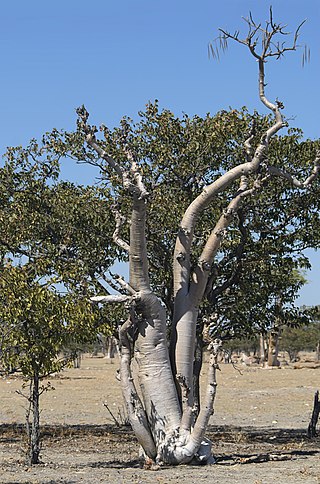
Moringa is the sole genus in the plant family Moringaceae. It contains 13 species, which occur in tropical and subtropical regions of Africa and Asia and that range in size from tiny herbs to massive trees. Moringa species grow quickly in many types of environments.
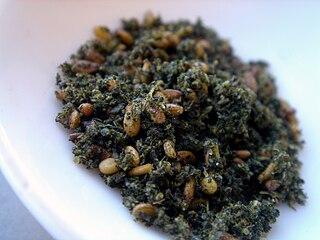
Za'atar is a Levantine culinary herb or family of herbs. It is also the name of a spice mixture that includes the herb along with toasted sesame seeds, dried sumac, often salt, and other spices. As a family of related Levantine herbs, it contains plants from the genera Origanum (oregano), Calamintha, Thymus, and Satureja (savory) plants. The name za'atar alone most properly applies to Origanum syriacum, considered in biblical scholarship to be the ezov of the Hebrew Bible, often translated as hyssop but distinct from modern Hyssopus officinalis.

Moringa oleifera is a fast-growing, drought-resistant tree of the family Moringaceae, native to Northern India and used extensively in South and Southeast Asia. Common names include moringa, drumstick tree, horseradish tree, or malunggay.

Calicotome spinosa, the thorny broom or spiny broom, is a very spiny, densely branched shrub of the family Fabaceae which can reach up to three metres in height. It grows in the Western Mediterranean region on sunny slopes and dry, rocky ground. It is found in Spain, France, Italy, Croatia, Morocco, Tunisia, Libya, Algeria and Turkey, and it has been introduced to New Zealand. From March to June it produces bright yellow flowers which are borne singly or in small clusters. The seed-pods are 30mm long and are almost hairless, unlike those of the similar species Calicotome villosa.
Blepharis dhofarensis is a species of plant in the family Acanthaceae. It is a shrub that grows to around 5m tall and is found in Oman and Yemen. Blepharis dhofarensis grows on wet escarpment woodlands and it prefers dense thickets on steep slopes. It is threatened by habitat loss. Recent molecular work has placed it in the genus Acanthus instead of Blepharis.
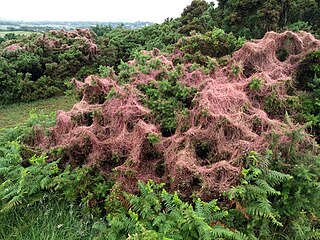
Cuscuta epithymum is a parasitic plant assigned to the family Cuscutaceae or Convolvulaceae, depending on the taxonomy. It is red-pigmented, not being photosynthetically active. It has a filiform habit, like a group of yarns. Its leaves are very small, like flakes. Its flowers, disposed in little glomerules, have a white corolla, with the androecium welded to the corolla.

Ruttya fruticosa, also known as jammy mouth or jêmbekkie, is a shrub which is native to Africa. It can be found in South Somalia to Tanzania and in the woodlands of Dhofar, Oman. The name Ruttya was named in honour of Dr John Rutty and fruticosa means shrubby and refers to the habit of the plant.
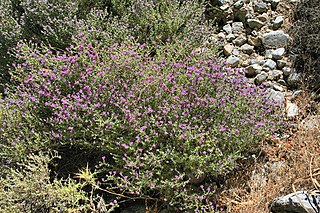
Thymus capitatus is a compact, woody perennial native to Mediterranean Europe and Turkey, more commonly known as conehead thyme, Persian-hyssop and Spanish oregano. It is also known under the name Thymbra capitata.

Moringa stenopetala, commonly known as the African Moringa or cabbage tree, is a deciduous tree in the plant genus Moringa, native to Kenya and Ethiopia. A drought-resistant species, it is characterized by its bottle-shaped trunk, long twisted seed pods, and edible leaves likened to cabbage, from which its common name is derived. M. stenopetala is extirpated in the wild in Ethiopia, though still grown there as a crop on the terraces of the Ethiopian Highlands, mainly in the Konso region.

Calicotome villosa, also known as hairy thorny broom and spiny broom, is a small shrubby tree native to the Mediterranean region.
Muhammad ibn Sa'id al-Tamimi, , known by his kunya, "Abu Abdullah," but more commonly as Al-Tamimi, was a tenth-century physician, who came to renown on account of his medical works. Born in Jerusalem, Al-Tamimi spent his early years in and around Jerusalem where he studied medicine under the tutelage of two local physicians, Al-Hasan ibn Abi Nu'aym, and a Christian monk, Anba Zecharia ben Thawabah. Al-Tamimi possessed an uncommon knowledge of plants and their properties, such that his service in this field was highly coveted and brought him to serve as the personal physician of the Ikhshidid Governor of Ramla, al-Hassan bin Abdullah bin Tughj al-Mastouli, before being asked to render his services in Old Cairo, Egypt. Around 970, Al-Tamimi had settled in Fustat, Egypt, and there prospered in his medical field, writing a medical work for the vizier, Ya'qub ibn Killis (930–991), a Baghdadi Jew who came to work in Egypt under the auspices of the Fatimids. He specialized in compounding simple drugs and medicines, but is especially known for his having concocted a theriac reputed as a proven antidote in snakebite and other poisons, which he named tiryaq al-fārūq because of its exceptional qualities.

Soda rosmarinus is a perennial-green desert species of saltwort in the Amaranthaceae family. It is endemic to the lower Jordan Valley along the Dead Sea, in Israel and Jordan, and in the Syrian desert, Central Iraq and in the coastal regions of Saudi Arabia, the islands of Bahrain, Qatar, and Iran, commonly known in Arabic by the names ʾušnān and šenān and in the Neo-Aramaic languages by reflexes of ʾuḥlā. It is often used by Bedouins for cleaning as a soap substitute. In medieval Arabic literature, it is also known by the names of "green ushnan" and "launderers' potash", having been used since time immemorial to produce nabulsi soap and as an electuary in compounding theriac for use in treating scorpion stings, as well as for extracting potassium for other medicinal uses.
Senna holosericea is a perennial herb with yellow flowers that is native to the Arabian Peninsula, Chad, Djibouti, Egypt, Eritrea, Ethiopia, India, Pakistan, Socotra, Somalia and Sudan.
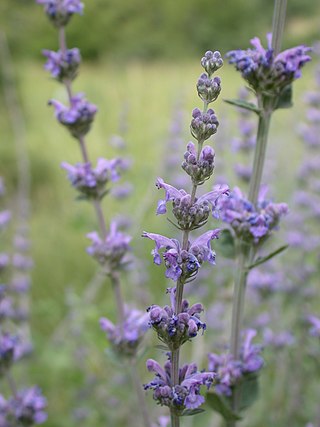
Nepeta curviflora, commonly known as Syrian catnip, is a herbaceous flowering plant native to the Middle East. It was first described in 1844.

Wild edible plants in the regions of Israel and Palestine have been used to sustain life in periods of scarcity and famine, or else simply used as a supplementary food source for additional nourishment and pleasure. The diverse flora of Israel and Palestine offers a wide range of plants suitable for human consumption, many of which have a long history of usage in the daily cuisines of its native peoples.

Delphinium peregrinum, also commonly known as violet larkspur, is a Eurasian flowering plant, belonging to the genus Delphinium, endemic to Turkey, the Eastern Mediterranean and Western Irano-Turanian region, bearing an erect, annual stem with glabrous compound leaves and reaching a height of 27–35 cm. The plant, which blossoms between April and August, bears five colorful sepals (calyx), petaloid, the posterior sepal spurred, the two lateral sepals and the two lower sepals without spurs; while the anterior sepals can either be fused or separated. The inflorescence (corollas) are sparsely arranged, irregular, and are borne on long pedicels subtended by bracts.

















